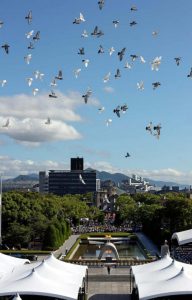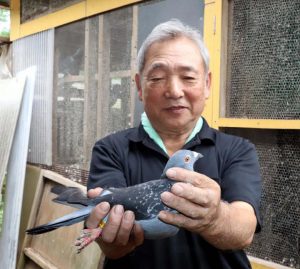From the Newsroom: The number of doves released at the peace ceremony seems to have become smaller. Actually, they are carrier pigeons. Dove fanciers lend them free of charge.
Aug. 10, 2023
Aging of owners, rise in prices of feed make it difficult to keep them
On August 6, the anniversary of the atomic bombing on Hiroshima, I posted on X (formerly Twitter) about the doves released at the Peace Memorial Ceremony held in Naka Ward, Hiroshima. They are actually carrier pigeons used for racing. This year there were 250 of them. The number has dropped sharply from its peak of 1,300. Trying to find why, I have found out the problems their owners face.
I visited Kiyoshi Hosokawa, 78, who keeps about 130 carrier pigeons in the mountainous area of the town of Kumano, Hiroshima Prefecture. He is a director of the Japan Carrier Pigeon Association and serves as an advisor for its Kure branch. “I have been keeping pigeons for more than 60 years, but both the keeper and the pigeons are tired,” he said in a sad voice.
A total of 250 doves were lent by 16 owners to be released at this year’s Peace Memorial Ceremony. This is almost half of 518 doves offered by 32 owners in 2017, the largest number in the past 10 years.
The number of owners is decreasing due to aging. In races, pigeons compete in the time they take to return from a designated location to their dovecotes following their homing instincts. The distances vary from 100 to 1,000 kilometers, and it is tough for owners to travel to distant places to release their pigeons for training. There are also financial burdens such as race entry fees and the cost of transportation. Prices of feed have also skyrocketed due to such factors as the Russian invasion of Ukraine. Takenori Iwata, 66, head of the Hiroshima branch of the association and owner of a bird shop in Minami Ward, Hiroshima, said, “Prices of feed have gone up 30 to 40% in the past few years.”
Some people have given up keeping doves because of complaints from their neighbors about the birds’ cooing and droppings. The membership of the Kure branch has dropped from a peak of about 130 to nine.
This is a time of suffering for doves, too. More and more of them have been attacked by hawks. “With changes in the environment, the number of snakes or frogs that hawks feed on may have decreased,” said Mr. Hosokawa. One of his 18 birds released at the ceremony has not returned. The same has happened to other owners. Mr. Hosokawa is in a position to ask other members to lend their birds. He said, “It is getting harder to say, 'Lend them for free of charge.’”
The day before the ceremony, owners bring their doves to the venue. City employees who are called “pigeon guards” take turns keeping watch over the birds until morning to make sure they are not attacked by cats or other animals. Doves were first released after the mayor’s peace declaration at the first Peace Festival held in 1947, and the scene has become a familiar sight.
Mr. Iwata’s father began lending doves for the ceremony, and Mr. Iwata has followed in his footsteps. “It is a sense of mission as a resident of Hiroshima. As long as I keep the doves, I want to help with the event with my wish for peace,” said Mr. Iwata. The scene people see every year and take for granted is supported by dove owners’ volunteer spirit.
This article was written by Chieri Ishii, a member of the Digital Team.
“My parents’ home is in a mountainous area in western Kagawa Prefecture. They have a Shikoku dog and a sheep. They do not have birds, but there is a chicken farm in front of the house.”
(Originally published on August 10, 2023)









